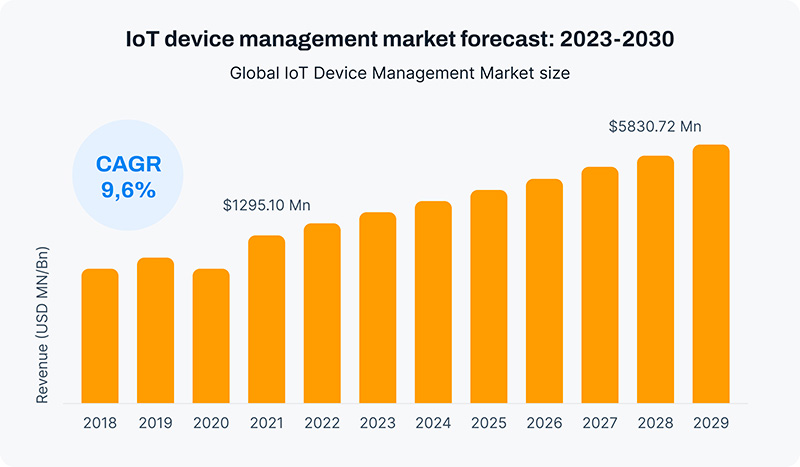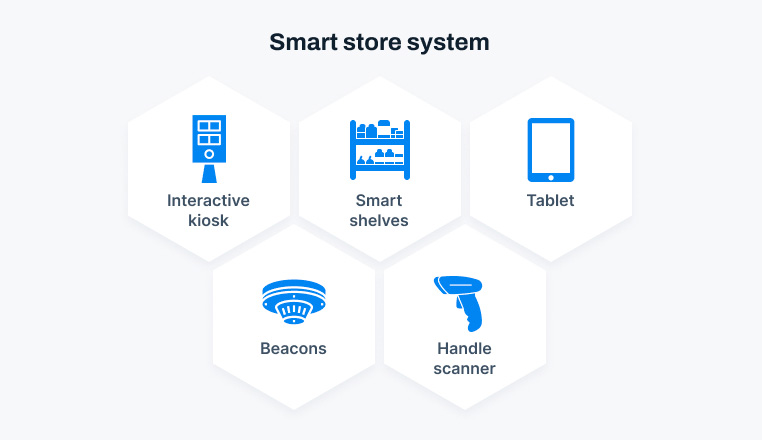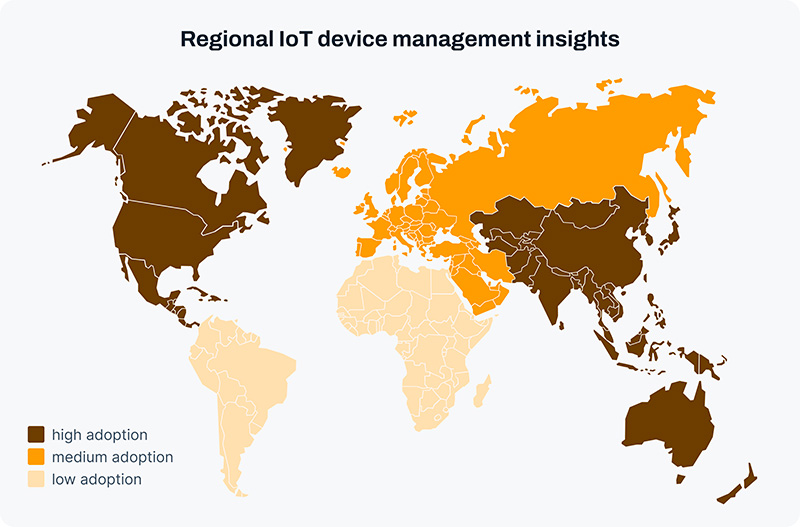IoT Device Management Market: Stats and Predictions
January 31, 2024In the fast-evolving technology industry, the Internet of Things (IoT) has become a transformative force that connects and reshapes devices in how we interact with the world. To emphasize forecasting the IoT market for the next decade, the growth of the IoT device management market promises to be thriving and full of extraordinary updates.
Before exploring the future, we should take a look at the present. The IoT device management market is now experiencing skyrocketing growth caused by huge demand for IoT devices across different industries. The IoT has become ubiquitous, from smart homes and healthcare assistance to agriculture systems and smart cities. With all our connected devices, the need for efficient, secure, and scalable device management systems has become more popular than ever.
Why does the device management market boom?
Several factors can influence the growth of the IoT device market over the next ten years.
Expanding IoT ecosystem
The IoT environment is promised to expand and break its borders to encompass more devices and industries. From smart appliances to industrial sensors and autonomous vehicles, this diversity of connected devices will drive the demand for robot-device solutions.
Security systems
As the number of connected devices expands, so does cybersecurity demand. The integration of IoT increases in some critical sectors that need cybersecurity protection. IoT device management solutions are vital in protecting data, making them irreplaceable in the coming years.
Computing advancements
The evolution of computing brings its power closer to the data source, reducing troubles and enhancing real-time processing possibilities. A shift demands more sophisticated and autonomous device management, fostering efficiency and flexibility in IoT ecosystems.
AI integration
The fusion of artificial intelligence (AI) into IoT systems gives broader device management capabilities. AI analytics and automation provide predictive maintenance, anomaly detection, and more. It enhances the effectiveness of work for connected devices.
Industry solutions
Device management solutions for a variety of industries will gain more perspective. Whether it's going to be healthcare, manufacturing, or green energy, customized approaches will address unique challenges and requirements.
Interoperability standards
Standardized protocols and interoperability frameworks will become paramount for the IoT industry. This provides communication and collaboration among devices from different manufacturers, fostering a closer IoT environment for other markets.
IoT market overview
The IoT device management market is full of competition. Besides, the pervasive adoption of IoT in various industry sectors gives this market opportunities.
As the depth and weight of IoT applications continue to grow across industries, it attracts new competitors to the market. Businesses have started to employ various marketing strategies to maintain their foothold in the global IoT device management services arena.
To ensure an advantageous position in the market, suppliers engage in competition across multiple aspects, including price, quality, brand recognition, and how their products or services differ. This competitive area underscores the market's dynamic nature and the strategies players developed to take the most prominent spot in the evolving world of IoT devices.
IoT market forecasting
The global IoT device management market reached $662.21 billion in 2023, which is forecasted to increase to $3,352.9 million by 2030. Sales in the IoT market are expected to experience significant growth at a noteworthy compound annual growth (CAGR) of 26.1%. The increasing demand for IoT services in any industry fueled the market's forward years. The IoT device management market is expected to thrive with such demand for infrastructure management solutions to make basic processes automatic for businesses.
The global market has grown alongside the agility of the Internet of Things for diverse applications. The constant improvement in technology and effective management of connected devices has led to the development of solutions such as real-time analysis, security measures, and advanced data management.
North America is the biggest player in the global market, taking a share of 28.6%. The region shows remarkable growth, with sales reaching $2 billion by 2030, driven by increased investments in IoT technology and government support. The North American IoT device management market benefits from giant key players like Google and PTC.
The United Kingdom is also experiencing a small transformation with a growth rate of 17.2% because the demand for private cloud solutions has surged, particularly during the COVID-19 pandemic, which caused an uptick in cyberattacks. Private clouds offer advanced privacy and security measures to safeguard personal information.
India aims to be the global IoT leader, showcasing a CAGR of 19.2% from 2023 to 2033. The country has become a substantial IoT market player, encompassing monitoring, provisioning, and maintaining.

IoT market trends
Retail
In the retail world, IoT devices completely change the rules, not just for businesses and organizations but for customers as well. Imagine a smoother shopping experience, increased conversions, and easier basic operations. That has its perks.
So, what do IoT devices bring to retail? Then, there are systems for store navigation, making it simple for customers to find what they need. Another valuable device is theft prevention. It's a crucial aspect that keeps retailers and customers safe.
Thanks to the IoT, retailers can tap into customer feedback by optimizing their approach to create an even better shopping experience. Store businesses are stepping into the future with IoT devices, making their lives easier and stores smarter.
These powerful devices manage energy efficiently. Sensors constantly monitor everything, from temperature and gas leaks to electricity breakdowns and energy usage.
With the sudden surge in demand for these solutions caused by cyber threats, store owners are wisely adopting these IoT solutions to eliminate risks. It's a winning strategy: smarter stores, happier owners, and safer shopping for customers.

Gaming consoles
Gaming consoles take over 3.7% of all connected devices, but they have experienced a slight decline in popularity from 4.8% in recent years. Even though they were going down, they managed to surpass smartwatches by gaining a strong position as one of the most popular connected devices.
Smart cities
Approximately 60% of the global population lives in urban areas, which makes cities ideal for IoT projects. The value of IoT impact extends across society, the environment and the economy of any urban city. Smart technology trends can be quickly involved in urban settings by leading to new solutions. To point out that the importance of intelligent utilities is on the rise and plays a vital role in running sector growth. The objective is to achieve energy efficiency, optimize resource distribution, and minimize waste for sustainability and efficiency in urban environments.
Supply chain
The IoT projects specializing in the supply chain sector have significantly boosted its growth rate, almost doubling in 2021 and 2022. Key components include tracking and monitoring solutions that streamline logistics processes and help them evolve.
Another element is digital twins, which use essential process metrics to simulate various scenarios. It helps avoid nefarious situations in planning and optimizing every aspect of logistics. Besides, smart innovations incorporate AI and robots to enhance the sector's potential for evolutionary achievements.
Healthcare
The healthcare sector embraces home health solutions and medical facilities, but these two aspects have experienced notable change due to the impact of the COVID-19 pandemic. Investment increases and the development of inventive solutions with innovative technology explain these significant changes. The one goal is to improve patient's health. This progress in medical technology is set to improve patient outcomes and simplify processes for healthcare providers and the healthcare delivery system.
These advancements cover wide aspects, including smart devices that monitor chronic diseases, watch post-operative recovery, and provide early warnings. Innovations such as smart tricorders, wearable technology, and diagnostic tools for medical purposes are also part of this progress and take care of any patients.
IoT device management: Regional insights

The IoT market thrives across several regions: North America, the Asia Pacific, the Middle East and Africa, Europe, and South America.
North America
North America valued the highest IoT market share for the 2023 year. The analysis showed growth in such industries as healthcare, automotive, and industrial sectors, promising to expand the user base.
The total number of connected devices reached 2.5 billion in North America during 2020. Moreover, cloud platforms have also become widely used in this region due to investments in IoT technologies and with represented leaders Google, Microsoft, Amazon, and IBM.
Europe
Europe is striving to dominate the market by overtaking North America. Healthcare is predicted to hold the most significant IoT market share in Europe. IoT devices are in close contact with big data. It provides various perks like diagnostics, description analysis, and predictive analysis. All devices combine with big data and expect to gain popularity in Europe. Demand for these technologies is increasing in Germany, the UK, France, Italy, and Spain, enhancing market growth.
Asia Pacific
Asia shows the highest CAGR because of the increased demand for smart city projects and initiatives in intelligent disease prediction and cloud app spending. Asia Pacific leaders Taiwan Mobile and Samsung Electronics are expanding their possibilities for smart device opportunities by developing new systems and combining advanced analytics into current systems.
Middle East and Africa
According to the forecasts, this region is expecting its growth to take part in the IoT industry. Middle Eastern countries have been engaged in smart city projects with a wish to build and create new smart cities that integrate this technology into existing ecosystems.
Conclusion
In conclusion, the IoT device management market continues to grow because of the constant demand in the industrial sector. The benefits of IoT device management, including connected computing, marketing automation, and supply chain analytics, have provided for its widespread use.
Furthermore, there are ongoing changes in IoT device management, such as boosting productivity, real-time device monitoring and updating, increased customer trust, and data security. The global IoT market is projected to grow significantly within the next few years, with a substantial CAGR of 26.1%.
The future for IoT device management looks promising, especially as businesses seek advanced infrastructure management solutions to automate operations. Notably, North America, Asia Pacific, and India. The IoT device management market outlook remains robust, promising innovation, efficiency, and transformative capabilities.
